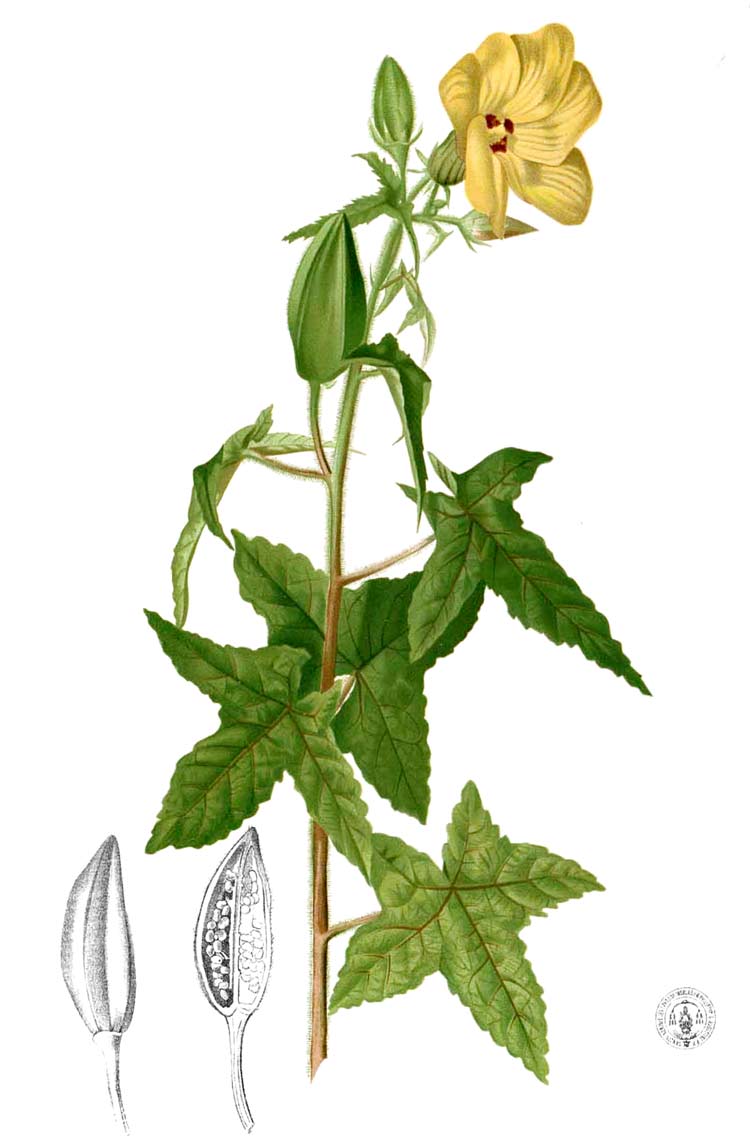
Abelmoschus moschatus (*)
Classification System: APG IV
Superregnum: Eukaryota
Regnum: Plantae
Cladus: Angiosperms
Cladus: Eudicots
Cladus: Core eudicots
Cladus: Rosids
Cladus: Eurosids II
Ordo: Malvales
Familia: Malvaceae
Subfamilia: Malvoideae
Tribus: Hibisceae
Genus: Abelmoschus
Species: Abelmoschus moschatus
Subspecies: A. m. subsp. biakensis – A. m. subsp. moschatus
Name
Abelmoschus moschatus Medik. (1787)
Synonyms
Homotypic
Abelmoschus abelmoschus (L.) Karst., Fl. Deutschl. ed vol. 2. 2, 157. 1894, nom. inadmiss.
Bamia abelmoschus (L.) Wall., Cat., no. 1915. 1828, nom. inval.
Hibiscus abelmoschus L., Sp. Pl. 1: 696. 1753.
Hibiscus moschatus (Medik.) Salisb., Prodr., 384. 1796, nom. illeg.
Hibiscus moschatus Roxb. ex Wight & Arn., Prod., 53. 1834, nom. illeg.
References
Mansfeld's World Database of Agriculture and Horticultural Crops (1998 onwards) IPK Gatersleben. Accessed: 2012 Feb 19.
Medikus, F.K. 1787. Ueber einige künstliche Geschlechter aus der Malven-Familie, denn der Klasse der Monadelphien. 46.
USDA, ARS, Germplasm Resources Information Network. Abelmoschus moschatus in the Germplasm Resources Information Network (GRIN), U.S. Department of Agriculture Agricultural Research Service. Accessed: 07-Oct-06.
Vernacular names
čeština: ibiškovec pižmový
English: musk-mallow, musk okra
français: ambrette
မြန်မာဘာသာ: ကွမ်းကတိုး
polski: ketmia piżmowa, piżmian właściwy
русский: абельмош мускатный
Abelmoschus moschatus (Abelmosk, ambrette, annual hibiscus, Bamia Moschata, Galu Gasturi, muskdana, musk mallow,[2] musk okra,[2] ornamental okra, rose mallow, tropical jewel hibiscus,[2] Yorka okra) is an aromatic and medicinal plant in the family Malvaceae native to Asia and Australia.[2]
Characteristics
The seeds have a sweet, flowery, heavy fragrance similar to that of musk (hence its specific epithet moschātus, scientific Latin for ‘musk’).
Despite its tropical origin, the plant is frost-hardy.
Uses of the plant
Musk mallow seed oil was once frequently used as a substitute in perfumes for animal musk; however this use is now mostly replaced by various synthetic musks due to its high cost.
In her 1705 book the Metamorphosis Insectorum Surinamensium, Maria Sibylla Merian described how the young indigenous women would string the seeds on threads and wear the seeds as decoration on their arms. She also indicated that the Indigenous people used the seeds to fatten up their chickens.[3]
Culinary uses
It has many culinary uses. The seeds are added to coffee; unripe pods ("musk okra"), leaves and new shoots are eaten as vegetables.
Medicinal uses
Different parts of the plant have uses in Ayurveda herbal medicine, including as an antispasmodic and to treat gonorrhea.[4] However, use may result in phytophotodermatitis and it has not been proven safe for use during pregnancy and lactation.[5]
Other uses
In industry the root mucilage provides sizing for paper; tobacco is sometimes flavoured with the flowers.
References
"The Plant List: A Working List of All Plant Species". Retrieved June 14, 2014.
"Abelmoschus moschatus". Germplasm Resources Information Network (GRIN). Agricultural Research Service (ARS), United States Department of Agriculture (USDA). Retrieved December 21, 2017.
Merian, Maria Sibylla (1705). Metamorphosis Insectorum Surinamensium. Amsterdam. pp. Plate 42.
L. D. Kapoor (2000). Handbook of Ayurvedic Medicinal Plants: Herbal Reference Library. Taylor & Francis. ISBN 9780849329296.
"Wellness Library:Ambrette (Abelmoschus moschatus)". Archived from the original on 2018-06-12. Retrieved 2018-06-10.
Brown, Deni (1995). The Royal Horticultural Society encyclopedia of herbs & their uses. London: Dorling Kindersley. ISBN 0-7513-0203-1.
Retrieved from "http://en.wikipedia.org/"
All text is available under the terms of the GNU Free Documentation License

